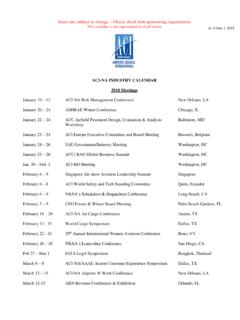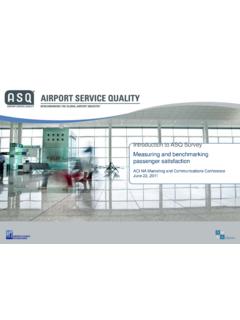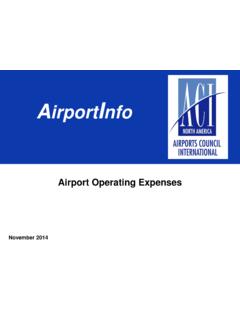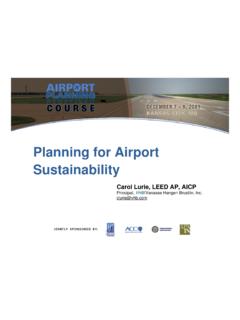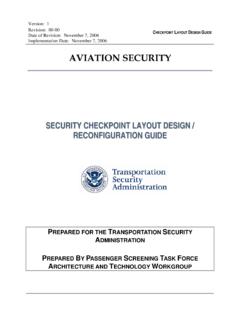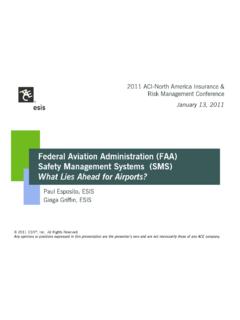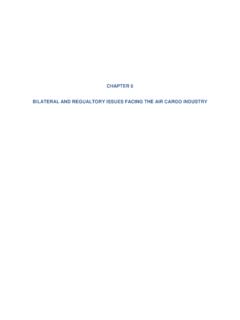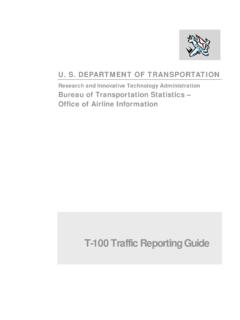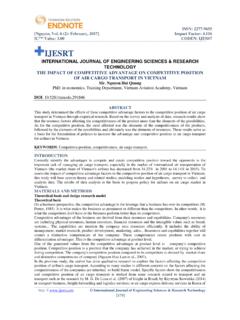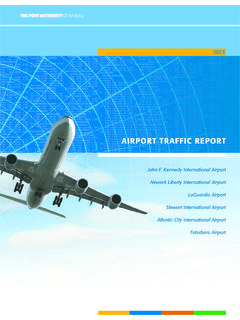Transcription of The Future Economics of the Airline Industry
1 The Future Economics of the Airline Industry A Changing Vernacular William S. Swelbar MIT International Center for Air Transportation Isn t It Interesting? The US Airline Industry is marginally profitable economic trends are weak Consumer confidence is anything but Manufacturing activity showing little to no expansion Passenger traffic up; cargo traffic is in decline European economic activity troubled Premium travel trends are exhibiting little growth IN THE Airline Industry IT S ALWAYS SOMETHING A Timeline of Events Impacting the Airline Industry In Relation to the Airline Index 2010: United and Continental merge 2010: Southwest acquires AirTran 2009: Delta airplane crotch bomber arrested 2009: Afghanistan surge 2009: H1N1 epidemic 2009: US unemployment rate reaches highest level since 1983 2008: Bear Sterns, AIG, Lehman, Washington Mutual collapse 2008-2009: Recession drives largest YOY revenue decline since 9/11.
2 Significant Industry capacity cuts 2008: Mumbai terrorist attack 2008: Madoff scandal 2007: Oil begins to rise toward $147/bbl, reached 7/2008 2001: 9/11 creates demand shock; Gov t offers financial assistance to Industry but ultimately many file for bankruptcy protection 2004: US Airways enters second bankruptcy 2002: US Airways enters first bankruptcy 2002-2003: SARS outbreak begins; slows travel demand, Mainly in Asia markets 2001: Dot Com recession weakens Industry trends 2001: Afghan War begins 2002: United airlines Enters bankruptcy 2003: Iraq War begins 2005: Hurricane Katrina; first oil spike 2006: UK airplane Terrorist plot carry on Liquids prohibited 2006: Subprime Mortgage crisis explodes 2007: Iraq surge 2005: America West and US Airways merge 2005: Delta and Northwest enter bankruptcy 2008: Delta and Northwest merge 4 An Industry Structure 30 Years in the Making Barriers to entry for new and existing carriers were removed Entry and growth of Low Cost Carriers a major driver of change Barriers to exit for inefficient carriers were erected Bankruptcy, government, labor as an internal source of capital Finally in the 2000 s.
3 Cost reductions and efficiency improvements that were expected during the previous two decades began to happen A market share mentality by the air carriers created an Industry that grew too big to be sustainable Significant capacity cutting/consolidation activity occurs The market share mentality has given way to a profit mentality Some Recent Headlines Uruguay Airline CEO warns of collapse US American deal seen as good for Charlotte US American merger would bring mixed results for CLT Qantas tumbles to record low after predicting profit drop Delta cleared to buy stake in Aeromexico Delta buys into an oil refinery Turkish airlines will not invest in LOT Polish airlines Airline stocks pummeled Monday WestJet raids Air Canada for New York fliers Don t expect lower fares as fuel costs drop S&P 500 falls 10% from 2012 peak amid economic slowdown concern airlines face sluggish long term growth over sluggish demand Crude oil prices drop to lowest levels since October The Best Thing That Happened During the Lost Decade The volatility in the price of oil and simply the price of oil has forever changed the mindset of Airline managers Taught airlines true capacity discipline Teaching airlines to focus on profitability Teaching airlines the need to be vigilant in balance sheet repair No more stupid capital 7 A New Vernacular Diversify the route portfolio De-leverage the balance sheet De-risk the operation Capacity cuts Cost constraints ex.
4 Fuel Profitability across the economic cycle Consolidation Pricing power through elimination of duplicative capacity Unbundling as a new and ancillary revenue source Global joint venture agreements Earning a return on invested capital Growth of market share v. margin degradation 8 CERA Conference, Houston, TX. March 11, 2011 Smisek said he expects United Continental, a merger last year of United airlines and Continental airlines , to shrink in the We'll have the domestic [operations] sized solely to feed the international traffic Thinking Outside the [Domestic] Box 10 The Future Lies Across the Ponds Airbus Global Market Forecast Annual Traffic Growth: 2009-2028 Boeing Current Market Outlook Annual Traffic Growth: 2009-2028 Source: ATA Diversification of the Route Portfolio Proving Critical to Improved Profitability 11 Percent of System ASM Percent of Capacity in International Markets 01020304050601995200020092011 AmericanDeltaUnitedUS AirwaysEven for Southwest, Profitable Domestic Opportunities are Minimal Raleigh/Durham Hartford Nashville Baltimore Columbus Denver Indianapolis Chicago-MDW Manchester Milwaukee Norfolk Pittsburgh Providence Louisville St.
5 Louis Jacksonville Austin Houston-HOU New Orleans San Antonio Ft. Lauderdale West Palm Beach New York-LaGuardia Kansas City Albany Buffalo/Niagara Falls Birmingham Phoenix Las Vegas Philadelphia Tampa Orlando Spokane Seattle/Tacoma Portland Boise Salt Lake City Reno/Tahoe Albuquerque Amarillo Tucson El Paso San Diego Omaha Minneapolis/ St. Paul South Padre Island Corpus Christy Charleston Greenville/ Spartanburg Washington Dulles New York-Newark Long Island Boston Cleveland Detroit Jackson Naples/ Ft. Myers Midland/ Odessa Lubbock Tulsa Oklahoma City Panama City Beach Little Rock San Jose San Francisco SFO Oakland Sacramento Los Angeles LAX Burbank Ontario Orange County Dallas Love Field 12 Capacity Cutting/Discipline Critical to Recent Industry Financial Performance -30-20-1001020304050 Jan 01 AprJulOctJan 02 AprJulOctJan 03 AprJulOctJan 04 AprJulOctJan 05 AprJulOctJan 06 AprJulOctJan 07 AprJulOctJan 08 AprJulOctJan 09 AprJulOctJan 10 AprJulOctJan 11 AprJulOctJan 12 Express ASM % ChangeMainline ASM % Change13 Passenger Commissions and the Internet A Classic Example of Competing Away the Efficiencies 0100020003000400050006000700080009000'78 '80'82'84'86'88'90'92'94'96'98'00'02'04' 06'080%2%4%6%8%10%12%14%Total Commission Cost (millions)Percent of Passenger RevenueTotal Commission Cost (millions)
6 Percent of Passenger Revenue 14 USA Non-USA Republic/Shuttle America Air France/KLM US Airways/America West Copa/AeroRep blica SkyWest/Atlantic Southeast Lufthansa/Swiss Pinnacle/Colgan Air China/Cathay Pacific* Lufthansa/JetBlue* Cathay Pacific/Dragonair Delta/Northwest Lufthansa/Brussels*/BMI/Austrian Republic/Midwest/Frontier Avianca/TACA United/Continental British Airways/Iberia Pinnacle/Mesaba LAN/TAM (pending) SkyWest-ASA/ExpressJet LAN/Aires* Southwest/AirTran TAM/TRIP* Consolidation a Most Important Catalyst for Improved Performance Selected M&A and/or Cross-Border Investment: 2005-Present Source: ATA and Deutsche Bank Global Research * Strategic investment but not full ownership or control 72% A Consolidating US Industry Source: SEC Filings and Company Reports. For 2010, United and Southwest are pro forma to include Continental and Air Tran *Data covers last twelve months ending June 30, 2011 2005 Revenue Market Share 2011* Revenue Market Share 53% Southwest/ AirTran 16 The Lower Cost Carriers Are Significant In Their Presence Today * Includes AirTran Percentage of Total ASMs Flown by US Carriers 1988 Percentage of Total ASMs Flown by US Carriers 2010 17 Globally, airlines Challenged to Cover Cost of Capital ROIC Below WACC Translates to Loss of Investor Wealth Source: Return on invested capital (ROIC) and weighted average cost of capital (WACC) from IATA (1993-2004) and Deutsche Bank (for 2010-2012 estimates) Percent 18 $ $ Corporate v.
7 Airline Profits The Performance Improvement in 2011 v. 2008 Is Telling of Progress Made $20$40$60$80$100$120$140-25%-20%-15%-10% -5%0%5%10%15%199019911992199319941995199 6199719981999200020012002200320042005200 620072008200920102011 ECorporate Profits (%) Airline Profits (%) Barrel Equivalent Cost of Jet Fuel /1 /1 West Texas Intermediate plus the implicit crack spread 19 Different Models of M&A Integration Examples Characteristics Advantages Disadvantages One Brand Co-Brand Multi-Brand Full integration One management One brand Maximum of synergies Fast decision processes Loss of a potentially well known brand Very high integration Integrated management Two brands Higher synergies Maintain (national) brands Higher complexity High integration Management teams Multi-brand Profit center orientation Maintain (national)
8 Brands Flexibility in growth Higher complexity 20 Lifecycle Development of Networks Little Differentiation Between Domestic and International Cooperation Economical Benefit/Complexity Special Prorate Agreement (SPA) (Free sale) Codesharing Merger/ M&A Depth of integration 100% no cooperation Interline Agreements Sales Incentive Agreement Blocked Seat Agreements (Codeshare) 1 2 3 4 5 6 8 Alliances JV Bilateral Joint Ventures (Revenue) Bilateral Joint Ventures (Profit) 7 21 Factors Affecting Future US Networks Factors airlines Control Capacity CAPX Aircraft Non-aircraft CASM ex Fuel Factors airlines Cannot Control Macro economy Positives ahead? Volatile energy prices Balance sheet pressure Regulatory environment Taxes and fees 22 A Strong Directional Correlation Between Consumer Sentiment and Airline Profitability Exists Consumer Sentiment Profit Margin for Airline Industry Source: University of Michigan 23 Source: MIT Airline Data Project $38B $27B The Relationship of Passenger Revenue to GDP 24 Isn t It Interesting?
9 The US Airline Industry is marginally profitable economic trends are weak Consumer confidence is well below optimum levels Manufacturing activity showing little to no expansion Air traffic up; cargo traffic is in decline but stabilizing? European economic activity troubled Premium travel trends are exhibiting little growth Airline actions to ensure sustainability run contrary to airport interests None more so than capacity cutting Consolidation is a second order effect negatively impacting Airline winners and losers are being identified Airport winners and losers less understood although the market is at work Regional sector evolution holds the answers for many airport markets Thinking that much of wholesale capacity cutting done Regional attrition will rule the day going forward Seasonal capacity adjustments are likely to be a bigger part of the vernacular Shape of the new Southwest/AirTran is certain to impact domestic architecture The economy does not promise to turn any marginal route opportunities into profitable opportunities in
10 The immediate term It took 30+ years to create the unsustainable network architecture that comprises the US air transport Industry today, it will take at least through this decade to determine its scope and scale in the next decade Conclusion/Thoughts The Middle East More a Threat to Europe than US Carriers 8,000 nm 4,500 nm 86% World Population 63% World GDP 2,500 nm 36% World Population 16% World GDP Source: Airbus 27 If vendors serving the Airline Industry are allowed to consolidate into dominant positions with few border restrictions, and .. If other industries like steel are permitted to consolidate market power around 4 global providers, If the global Airline Industry has not one dominant player, and .. If Joint Ventures only capture 50% of potential synergies, If the five biggest alliance members produce 60% of the benefits, and.
